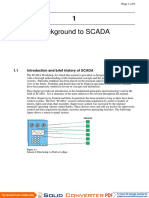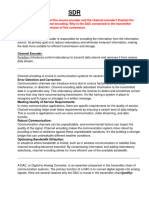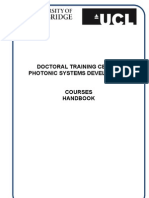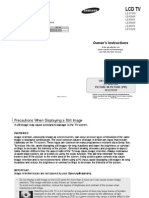2.data Acquisition System and 3.virtual Instrumentation
2.data Acquisition System and 3.virtual Instrumentation
Uploaded by
mohammadanas7686Copyright:
Available Formats
2.data Acquisition System and 3.virtual Instrumentation
2.data Acquisition System and 3.virtual Instrumentation
Uploaded by
mohammadanas7686Original Description:
Original Title
Copyright
Available Formats
Share this document
Did you find this document useful?
Is this content inappropriate?
Copyright:
Available Formats
2.data Acquisition System and 3.virtual Instrumentation
2.data Acquisition System and 3.virtual Instrumentation
Uploaded by
mohammadanas7686Copyright:
Available Formats
21AR43 Instrumentation & Control Systems
2. Data Acquisition System
Data Acquisition (DAQ) System:
• Data acquisition (DAQ) systems are the main instruments used in laboratory research
from scientists and engineers; in particular, for test and measurement, automation, and so
on.
• Typically, DAQ systems are general-purpose DAQ instruments that are well suited for
measuring voltage or current signals.
• However, many sensors and transducers output signals must be conditioned before that a
board can acquire and transform in digital the signal.
Elements of DAQ
The basic elements of DAQ are:
• Sensors and transducers
• Field wiring
• Signal conditioning
• DAQ hardware
• DAQ software
• PC (with operating system)
Dept of R&A, Sahyadri College of Engineering & Mgt Page 1
21AR43 Instrumentation & Control Systems
Benefits of Data Acquisition Systems
The advantages of data acquisition systems include:
Accuracy
Flexibility
Scalable
High Efficiency and Reliability of Processes
Faster Analysis and Resolution of Problems
Reduced Data Redundancy
Decrease in Update Errors
Improved Integration of Data through Less Reliance on Other Programs
Improved Access to Data for Users
Supervision of Processes without Human Interaction
Improved Data Security
Cost-Effectiveness
Quality Control
Data Acquisition Systems are Highly Versatile
Better File Processing and Transfer Capabilities
DAQ Systems
The functional diagram of a typical DAQ system can be described of the following main
components:
• Input multiplexer
• Input signal amplifier
• Sample and hold circuit
• A/D converter
• Memory (DMA)
• Timing system and filtering
• Bus interface
• Digital signal processing
• Microprocessor and/or Field-Programmable Gate Array
Dept of R&A, Sahyadri College of Engineering & Mgt Page 2
21AR43 Instrumentation & Control Systems
Types of Data Acquisition Systems
The types of data acquisition systems include:
Data Loggers
Data logging is the process whereby collected data is recorded. This data is collected over
a defined amount of time. Data loggers tend to be small and they are mostly used for the
measurement of relatively small signals. Many of these data acquisition systems are
intended for the collection of data over a long period of time.
Depending on the type of application, the data can be used to read voltages, temperature
measurements, humidity levels, currents, or other signals of interest. Data loggers are
self-contained data acquisition systems with built-in processors and predefined software
embedded in the unit.
A data logger is capable of running as a standalone device. Data loggers are popular due
to their portability as well as ease of use for specific tasks. Every data logger consists of
local storage capacity for saving data. Some data loggers include SD (secure digital) slots
as a means for providing additional memory through the utilization of memory cards
(featuring memory chips). The data may be collected and temporarily stored on an
individual data logger and then sent via a data link ( a removable memory card) at
Dept of R&A, Sahyadri College of Engineering & Mgt Page 3
21AR43 Instrumentation & Control Systems
regular, convenient intervals. Some web-enabled data loggers can even be configured to
directly share their data over a network.
Some data loggers are battery-powered for additional portability. By definition, a data
logger will consist of a more limited set of inputs and tend to have a more basic format
like the already mentioned signals including temperature, current, voltage, etc. Data
loggers can also be used for the collection of geological data for long-term monitoring of
many items.
Data Acquisition Devices
Data acquisition devices contain signal conditioning circuitry, as well as an analog-to-
digital converter. However, they need to be connected to a computer in order to function.
Data acquisition devices are a popular choice because they are very flexible and very
useful in various applications. Data acquisition devices are DAQ systems that are more
complex than data logging systems. However, they do not have the complexity of a full
rack-based DAQ system. Data acquisition devices are likely to utilize single devices to
which all the sensors can be connected into a full DAQ system.
Data acquisition devices are capable of providing more functionality than data loggers
and they are less costly than full rack-based systems. Most of these items are USB data
acquisition systems. There are plug-in devices that are used in data acquisition. Users of
these devices can either use predefined data acquisition software such as DAQami, or
they can also make use of a programming environment like C++, MATLAB, Python, and
DASYLab. Data acquisition devices offer a customizable solution for unique
applications, with different BUS options as well as the flexibility to function as a part of a
larger DAS system.
Modular Data Acquisition Systems
Modular data acquisition systems are designed for high-channel count devices offering
many input channels, as well as complex systems that require integration and
synchronization of many types of sensors. These systems are utilized in more demanding
situations. The integration and use of these systems are more complex, but they are
extremely flexible. These modular systems are the most expensive data acquisition
option. However, based on the complex functions performed, many DAQ systems
contain features that can only be provided by a modular data acquisition system like PXI.
Both static, as well as dynamic measurements, can be performed by these DAQ systems;
therefore, they are capable of both low-speed and high-speed sampling.
Modular data acquisition systems usually have a high-powered computer associated with
them due to the demands that are placed on them. The computer associated with these
systems is either built-in or connected to them. In this way, data acquisition systems offer
maximum as well as flexible performance, but this comes with an additional cost.
Modular data acquisition systems can come in larger racks although many compact DAQ
systems are also available.
Dept of R&A, Sahyadri College of Engineering & Mgt Page 4
21AR43 Instrumentation & Control Systems
A/D converters
• An ADC is an electronic device that converts an input analog voltage or current to a
digital number proportional to the magnitude of the voltage or current.
• However, some non-electronic or only partially electronic devices, such as rotary
encoders, can also be considered ADCs. The number of output bits from an ADC doesn’t
fully specify its behavior.
Parameters of AD Converters
Some important factors can be described in the following points:
• Input voltage range: The input voltage range of an ADC is determined by the reference
voltage applied to the ADC.
• Resolution: The resolution, expressed in bits, of the converter indicates the number of
discrete values (binary) that can be produced over the range of analog values.
Dept of R&A, Sahyadri College of Engineering & Mgt Page 5
21AR43 Instrumentation & Control Systems
• Quantization error: Quantization error is an artifact of representing an analog signal
with a digital number
• Conversion mode: A conversion mode is a method in which the ADC processes the
input. A standard ADC has two types of conversion modes: single ended conversion
mode and differential conversion mode
• Offset error: The offset error is defined as the deviation of the actual ADCs transfer
function from the perfect ADCs transfer function related at the point of LSB.
D/A converters
• A DAC is an electronic device that converts a digital (usually binary) signal to an analog
signal (current, voltage, or electric charge).
• A common use of DACs is the generation of audio signals from digital information in
music players.
Parameters of DA Converters
The most important characteristics of these devices are:
• Resolution: This is the number of possible output levels the DAC is designed to
reproduce.
• Monotonicity: Ability of a DAC’s analog output to move only in the direction that the
digital input moves.
• Full scale range (FSR): Maximum output signal for the DAC.
• SFDR, Spurious Free Dynamic Range: The difference between the RMS power of the
fundamental frequency and the largest spurious signal in the bandwidth.
Dept of R&A, Sahyadri College of Engineering & Mgt Page 6
21AR43 Instrumentation & Control Systems
Organisation of the DAQ VI system
Opto-isolation (Opto-coupler)
• An optoisolator (also known as an optical coupler, photocoupler, optocoupler) is
a semiconductor device that transfers an electrical signal between isolated circuits using
light.
• These electronic components are used in a wide variety of communications and
monitoring systems that use electrical isolation to prevent high voltage emitters from
affecting lower power circuitry receiving a signal.
Working of Opto-isolation:
1. The schematic of an optoisolator consists of an emitter, in this case an infrared light-
emitting diode (IRED) or laser diode for input signal transmission and a photosensor (or
Dept of R&A, Sahyadri College of Engineering & Mgt Page 7
21AR43 Instrumentation & Control Systems
phototransistor) for signal reception. In this way, the input signal can either generate
electric energy or modulate an electrical current that's coming from an electronic device
or other power supply.
2. When the input current is applied to the LED photodiode (a common type
of photosensor), infrared light is produced and passes through the material inside the
optical isolator. The beam travels across a transparent gap and is picked up by the
receiver, which acts as a converter. Using signal isolation, the sensor is able to transform
the modulated light back into an output signal.
3. The input side of optoisolators could be a photoresistor, a photodiode, a phototransistor, a
silicon-controlled rectifier or a triac. An optocoupled solid-state relay contains a
photodiode optoisolator that drives a power switch on the output side, usually a
complementary pair of MOSFETs.
Dept of R&A, Sahyadri College of Engineering & Mgt Page 8
21AR43 Instrumentation & Control Systems
3 Virtual Instrumentation
Virtual Instrumentation
• Virtual instrumentation combines mainstream commercial technologies, such as the PC,
with flexible software and a wide variety of measurement and control hardware.
• Engineers use virtual instrumentation to bring the power of flexible software and PC
technology to test, control and design applications making accurate analog and digital
measurements.
• Engineers and scientists can create user-defined systems that meet their exact application
needs.
• Industries with automated processes, such as chemical or manufacturing plants use virtual
instrumentation with the goal of improving system productivity, reliability, safety,
optimization and stability.
Architecture for Virtual Instruments
A virtual instrument is composed of the following blocks:
– Sensor module
– Sensor interface
– Information systems interface
– Processing module
– Database interface
– User interface
Dept of R&A, Sahyadri College of Engineering & Mgt Page 9
21AR43 Instrumentation & Control Systems
Sensor Module:
The sensor module performs signal conditioning and transforms it into a digital form for further
manipulation. Once the data are in a digital form on a computer, they can be displayed,
processed, mixed, compared, stored in a database, or converted back to analog form for further
process control. The database can also store configuration settings and signal records. The sensor
module interfaces a virtual instrument to the external, mostly analog world transforming
measured signals into computer readable form.
Sensor Interface:
There are many interfaces used for communication between sensors modules and the computer.
According to the type of connection, sensor interfaces can be classified as wired and wireless.
Processing Module:
Integration of the general purpose microprocessors/microcontrollers allowed flexible
implementation of sophisticated processing functions. As the functionality of a virtual instrument
depends very little on dedicated hardware, which principally does not perform any complex
processing, functionality and appearance of the virtual instrument may be completely changed
utilizing different processing functions.
Database Interface:
Computerized instrumentation allows measured data to be stored for off-line processing, or to
keep records as a part of the patient record.
Information System Interface:
Virtual instruments are increasingly integrated with other medical information systems, such as
hospital information systems. They can be used to create executive dashboards, supporting
decision support, real time alerts, and predictive warnings.
Dept of R&A, Sahyadri College of Engineering & Mgt Page 10
21AR43 Instrumentation & Control Systems
Traditional Instruments versus Virtual Instruments
Dept of R&A, Sahyadri College of Engineering & Mgt Page 11
21AR43 Instrumentation & Control Systems
Programming Techniques VI
Lab VIEW programs are called virtual instruments (VIs).
Controls are inputs and indicators are outputs.
Each VI contains three main parts:
Front Panel – How the user interacts with the VI.
Block Diagram – The code that controls the program.
Icon/Connector – Means of connecting a VI to other VIs.
Front Panel
The front panel can include knobs, push buttons, graphs and various other controls (which are
user inputs) and indicators (which are program outputs). Controls are inputs used to simulate
instrument input devices and supply data to the block diagram of the VI, and indicators are
outputs displays used to simulate instrument output devices and display data the block diagram
acquires or generates. The front panel is customized to emulate control panels of traditional
instruments, create custom test panels, or visually represent the control and operation of
processes.
Dept of R&A, Sahyadri College of Engineering & Mgt Page 12
21AR43 Instrumentation & Control Systems
Dept of R&A, Sahyadri College of Engineering & Mgt Page 13
21AR43 Instrumentation & Control Systems
Block Diagram
The block diagrams accompany the program for the front panel. Front panel objects appear as
terminals on the block diagram and the components wired together. After the front panel is built,
codes are added using graphical representations of functions in the block diagram to control the
front panel objects. The block diagram contains the graphical source code composed of nodes,
terminals, and wires. The components of a block diagram are lower-level VIs, built-in functions,
constants and program execution control structures.
Dept of R&A, Sahyadri College of Engineering & Mgt Page 14
21AR43 Instrumentation & Control Systems
Dept of R&A, Sahyadri College of Engineering & Mgt Page 15
You might also like
- Presentation On Distribution Automation System (DAS)Document18 pagesPresentation On Distribution Automation System (DAS)A I Md. Sajed Arefin83% (6)
- SSP0666AENDocument72 pagesSSP0666AENThang Tong100% (1)
- Daq 150420110317 Conversion Gate01 PDFDocument17 pagesDaq 150420110317 Conversion Gate01 PDFBabu TNo ratings yet
- Data Acquisition Systems: Assignment EC375-Measurements and InstrumentationDocument10 pagesData Acquisition Systems: Assignment EC375-Measurements and InstrumentationAfrasinei Sergiu VladNo ratings yet
- SA Unit 4 - Session 1-1Document34 pagesSA Unit 4 - Session 1-1Yashi SinghNo ratings yet
- Data Acquisition: Fig 2.1:-Parts of Measurement SystemDocument16 pagesData Acquisition: Fig 2.1:-Parts of Measurement SystemHayder AliNo ratings yet
- Lecture 2.1Document3 pagesLecture 2.1FELIX ORATINo ratings yet
- Industrial AutomationDocument107 pagesIndustrial AutomationArivukkarasan RajaNo ratings yet
- Adv Instr Lecture 3Document67 pagesAdv Instr Lecture 3Rayees Khan TareenNo ratings yet
- 2 Data Acquisition SystemsDocument38 pages2 Data Acquisition SystemsumarsaboNo ratings yet
- DAQDocument15 pagesDAQZahid HasanNo ratings yet
- Unit 5Document147 pagesUnit 5PeaceNo ratings yet
- TN 324: Intelligent InstrumentationDocument29 pagesTN 324: Intelligent InstrumentationAlango Jr TzNo ratings yet
- 4 Things To Consider When Using A DAQ As A Data LoggerDocument30 pages4 Things To Consider When Using A DAQ As A Data LoggerPuiu AntonNo ratings yet
- 12 Data AcqusitionDocument12 pages12 Data AcqusitioncapNo ratings yet
- DCS Practical 7Document9 pagesDCS Practical 7Vj NadarNo ratings yet
- Data Acquisition SystemsDocument22 pagesData Acquisition SystemsRajNo ratings yet
- Data Acquisition: Navigation SearchDocument3 pagesData Acquisition: Navigation SearchSwetha CNo ratings yet
- Module 6Document68 pagesModule 6Jayasree ManoharanNo ratings yet
- DAQ SlidesDocument13 pagesDAQ Slidessabrinangowe723No ratings yet
- Review of Computers in Process Control 1.1 Data LoggersDocument30 pagesReview of Computers in Process Control 1.1 Data Loggerssisai12u242No ratings yet
- MT6603 DMS Unt 3 PDFDocument39 pagesMT6603 DMS Unt 3 PDFKarthi KeyanNo ratings yet
- Introduction To ScadaDocument97 pagesIntroduction To ScadaNicholas SheltonNo ratings yet
- Industrial Automation Unit V: Prepared By: Pradnya SadigaleDocument31 pagesIndustrial Automation Unit V: Prepared By: Pradnya Sadigalepradnya sadigaleNo ratings yet
- Data Logger: What's The Difference Between Data Loggers and Data Acquisition?Document5 pagesData Logger: What's The Difference Between Data Loggers and Data Acquisition?kide welegergsNo ratings yet
- S&I Unit4-1Document12 pagesS&I Unit4-1singhanisha073No ratings yet
- Oan551 Sensors and Transducers: Sns College of EngineeringDocument18 pagesOan551 Sensors and Transducers: Sns College of EngineeringRavi JNo ratings yet
- SCADA As Heart of Distribution Management System PDFDocument9 pagesSCADA As Heart of Distribution Management System PDFomar_skt_gnrNo ratings yet
- Presentation DSD 01.12.24 PDFDocument10 pagesPresentation DSD 01.12.24 PDFengtawkibhasanNo ratings yet
- Scada: (Supervisory Control and Data Acquisition)Document13 pagesScada: (Supervisory Control and Data Acquisition)AdamuNo ratings yet
- Es Unit1 PPT FinalDocument99 pagesEs Unit1 PPT FinalYadavilli VinayNo ratings yet
- ScadaDocument28 pagesScadaPanchal DeepNo ratings yet
- Dataacquisitionsystem 141028142838 Conversion Gate01Document25 pagesDataacquisitionsystem 141028142838 Conversion Gate01priyaNo ratings yet
- Data Acquisition System: Sumeet Patel Enroll. No. - 110050111040Document25 pagesData Acquisition System: Sumeet Patel Enroll. No. - 110050111040Princy Merin JoseNo ratings yet
- Vsnet Scada: Valquest Systems, IncDocument4 pagesVsnet Scada: Valquest Systems, IncAkshay GatkalNo ratings yet
- Using MATLAB For Vibration MeasurementsDocument12 pagesUsing MATLAB For Vibration MeasurementsAekDzLaiNo ratings yet
- Background To SCADA: 1.1 Introduction and Brief History of SCADADocument9 pagesBackground To SCADA: 1.1 Introduction and Brief History of SCADAAhmedNo ratings yet
- SCADA_System_of_NLDCDocument38 pagesSCADA_System_of_NLDCsutkqjcvpczteytklzNo ratings yet
- Scad ADocument31 pagesScad AnareshkattaNo ratings yet
- Data AcquisitionDocument4 pagesData Acquisitionmattew657No ratings yet
- D07_SCADADocument19 pagesD07_SCADAKhoa NguyễnNo ratings yet
- APU - SPACC - 09 - Data Acquisition FundamentalsDocument29 pagesAPU - SPACC - 09 - Data Acquisition FundamentalsDiana RoseNo ratings yet
- ECE - Design of Data Acquisition - P.a.shindeDocument8 pagesECE - Design of Data Acquisition - P.a.shindeTJPRC PublicationsNo ratings yet
- Module 4.PptDocument33 pagesModule 4.PptPrakrutiNo ratings yet
- Chapter 5Document18 pagesChapter 5Tejan Kumar SharmaNo ratings yet
- Channel EncoderDocument45 pagesChannel Encodersurajsinghssd5No ratings yet
- ReportDocument8 pagesReporthuzaifa zainNo ratings yet
- ERACS Software ManualDocument10 pagesERACS Software ManualPui Yee GohNo ratings yet
- Dcs Vs ScadaDocument44 pagesDcs Vs ScadaSAYED QAISAR SHAH100% (3)
- Data Acquisition System: Er. Saurabh MalpotraDocument23 pagesData Acquisition System: Er. Saurabh MalpotraCr ZyNo ratings yet
- Data Aquisition PDFDocument28 pagesData Aquisition PDFyaregal limenihNo ratings yet
- 1.2 Parts of A DAQ SystemDocument37 pages1.2 Parts of A DAQ SystemMaddipati SumanthNo ratings yet
- DSP BASED Design FlowDocument17 pagesDSP BASED Design Flowdeepu110304No ratings yet
- Unit 3 System Interfacing and ControllersDocument48 pagesUnit 3 System Interfacing and ControllersSrinivasan V PNo ratings yet
- MP-Based Automated Systems - Lecture 6Document55 pagesMP-Based Automated Systems - Lecture 6mohamed orifNo ratings yet
- ScadaDocument23 pagesScadaMrutunjay NalwadNo ratings yet
- Scada Systems in Tneb 221213Document103 pagesScada Systems in Tneb 221213Neelakandan Masilamani100% (1)
- DCS Lesson Part 1Document27 pagesDCS Lesson Part 1Cauilan JerwenNo ratings yet
- Unit 5Document23 pagesUnit 5shreyas shahNo ratings yet
- DC Analysis of Differential AmplifierDocument9 pagesDC Analysis of Differential AmplifierJay ReposoNo ratings yet
- ENG1013 Week 7 Electrical Problem SheetDocument2 pagesENG1013 Week 7 Electrical Problem Sheetibra0007No ratings yet
- CD T Courses 2011Document33 pagesCD T Courses 2011Pranav KalagaNo ratings yet
- Ece 374 Part 7 Mosfet 3Document14 pagesEce 374 Part 7 Mosfet 3Zakaria ElwalilyNo ratings yet
- Canache Daniel: 09-2014 PresentDocument3 pagesCanache Daniel: 09-2014 PresentAlexandraOrosNo ratings yet
- Experiment 5Document12 pagesExperiment 5Abdullah ShahNo ratings yet
- IC - LineDriverRS422 Am26ls31mDocument28 pagesIC - LineDriverRS422 Am26ls31mLeonardo GunawanNo ratings yet
- EC8651 TLW Unit 3 2 MarksDocument2 pagesEC8651 TLW Unit 3 2 MarksDhanaraj P0% (1)
- Quiz TecDocument3 pagesQuiz TeclauraNo ratings yet
- Deep SubmicronDocument20 pagesDeep SubmicronArchana Rk50% (2)
- Creating Ethernet CablesDocument18 pagesCreating Ethernet CablesRona Belle Trapago RaveloNo ratings yet
- MC302 Section 1 Rev1Document20 pagesMC302 Section 1 Rev1Антон ЖлобинNo ratings yet
- Net Optics 10/100/1000baset TapDocument2 pagesNet Optics 10/100/1000baset TapAchmad Arthur Pradhana R-No ratings yet
- 1Document10 pages1Wavtech SimmakkalNo ratings yet
- LCD TV Repair Case Histories PDFDocument33 pagesLCD TV Repair Case Histories PDFMar DocdorNo ratings yet
- An Integrated Circuit TesterDocument6 pagesAn Integrated Circuit TesterlvrevathiNo ratings yet
- X1-Hybrid: Single Phase Hybrid InverterDocument2 pagesX1-Hybrid: Single Phase Hybrid InverterPMV DeptNo ratings yet
- Check List For TransformerDocument2 pagesCheck List For TransformerKyaw HtikeNo ratings yet
- Quanser - IP01 and IP02 User ManualDocument29 pagesQuanser - IP01 and IP02 User ManualHygor ViegasNo ratings yet
- Chapter 3: Keys and Displays: 1/32 DIN (PM3)Document2 pagesChapter 3: Keys and Displays: 1/32 DIN (PM3)Henry WildNo ratings yet
- Biomedical Signal ProcessingDocument72 pagesBiomedical Signal Processingapi-19807868No ratings yet
- Transmission Lines (Blake C14) : True/FalseDocument6 pagesTransmission Lines (Blake C14) : True/FalseLovely Eulin FulgarNo ratings yet
- Acc 34Document28 pagesAcc 34AlfNo ratings yet
- TLW-Unit 1Document5 pagesTLW-Unit 1Darwin RNo ratings yet
- Resistor Color Code WorksheetDocument4 pagesResistor Color Code WorksheetArthur RodriguesNo ratings yet
- Nec PD765Document28 pagesNec PD765Fabio Alexandre SpanholNo ratings yet
- Samsung LCD LE40N87BDDocument66 pagesSamsung LCD LE40N87BDgafaraNo ratings yet
- Office Security SystemDocument6 pagesOffice Security SystemIJMERNo ratings yet
- Lenovo - ArchDocument6 pagesLenovo - ArchplopenNo ratings yet

























































































